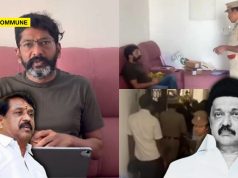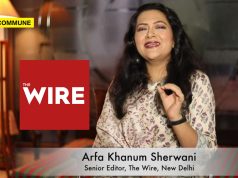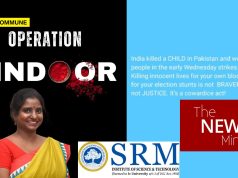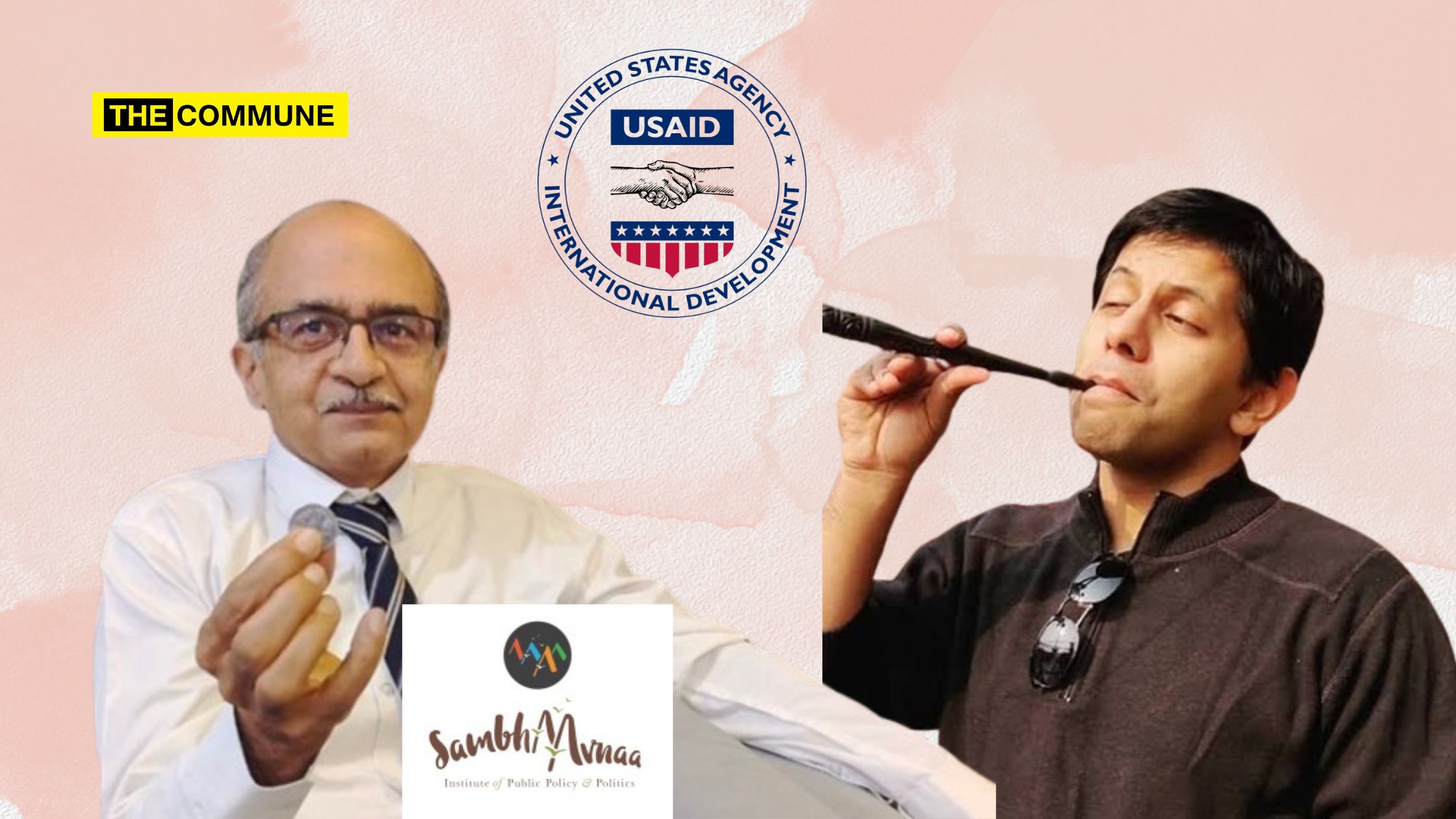
In February 2025, WikiLeaks exposed a massive funding operation by the United States Agency for International Development (USAID), revealing its financial backing of the anti-India ecosystem. This revelation exposed the deep involvement of USAID in shaping narratives critical of the Indian government, particularly through organizations like Internews and its Indian affiliates. One of the most notable connections was Prashant Bhushan’s Sambhaavnaa Institute of Public Policy and Politics, which has long been a hub for left-leaning media figures and activists critical of the Modi government. This exposure raised serious questions about the extent of foreign interference in India’s internal affairs, particularly through media and social influence campaigns.
US Embassy & Association With “Influencers” In India
Let’s jog our memory a bit – In July 2024, the US Embassy in India announced an event for Indian social media influencers and content creators, branded as “Influence to Impact,” scheduled for 25 July 2024. The event aimed to enhance digital engagement on social issues and promote “active citizenship.” However, the selection of YouTuber “DeshBhakt” Akash Banerjee—known for his leftist and anti-BJP propaganda—as the key speaker raised eyebrows. While the initiative appeared neutral on the surface, the embassy’s promotional content suggested subtle political interference in India’s internal discourse. This raised a fundamental question: Why was the US Embassy in India so invested in shaping Indian public opinion on domestic issues? Was it their role to push narratives on “active citizenship,” or was it an attempt to subtly interfere in India’s political landscape, especially given the Modi government’s firm stance against direct foreign intervention?
That was not the first time the US Embassy in India amplified voices known for their leftist and anti-BJP views. In March 2023, the embassy endorsed controversial radio jockey Sayema Rahman for Women’s History Month, sparking outrage due to her history of anti-Hindu and Islamist rhetoric. Despite widespread criticism, the embassy promoted Sayema as a voice for democracy. Similarly, the selection of Akash Banerjee for the “Influence to Impact” event drew backlash, given his controversial content, including trivializing the brutal rape and murder of Nirbhaya. By positioning Banerjee as a mentor to Indian influencers, the embassy’s repeated endorsement of such figures raised concerns about whether the US was genuinely promoting meaningful change or grooming Indian influencers to push narratives aligned with American interests.
Sambhaavnaa Institute & Akash Banerjee
The Sambhaavnaa Institute of Public Policy and Politics, established in 2004 by Prashant Bhushan under the Kumud Bhushan Education Society, claims to address societal injustices but has been accused of fostering a left-leaning media ecosystem in India.
1. The Birth
"Sambhaavnaa Institute of Public Policy and Politics" was established under "Kumud Bhushan Education Society" by the Son of Late Advocate Shahsi Bhushan and Mrs Kumud Bhhushan, Supreme Court Advocate Prashant Bhushan in the year 2004. In the year 2010, Prashant… pic.twitter.com/m3iA7hFrci
— The Story Teller (@IamTheStory__) February 9, 2025
Located in Kandbari village, Himachal Pradesh, the institute has become a hub for workshops featuring prominent leftist figures, including Yogendra Yadav, Harsh Mander, Medha Patkar, Pratik Sinha (Alt News), Ravish Kumar, and others. These individuals are known for their anti-BJP and anti-Hindu rhetoric, raising questions about the institute’s true agenda.
2. The Cabal
When you look at the perosns associated with “Sambhaavnaa Institute of Public Policy and Politics” as its resource people for discussions and workshops,
it looks like a soiree of Leftist ecosystem in India!!Here are the names of those resource people:
1.… pic.twitter.com/k6KbZTubkl
— The Story Teller (@IamTheStory__) February 9, 2025
The institute’s network includes journalists and media professionals such as Paranjoy Guha Thakurta, Ravleen Kaur, Atul Chaurasia (Newslaundry), and Akash Banerjee (DeshBhakt), who is listed as one of its “resource people.” Banerjee, a YouTuber known for his anti-BJP propaganda, has been actively involved in shaping narratives critical of the Indian government.
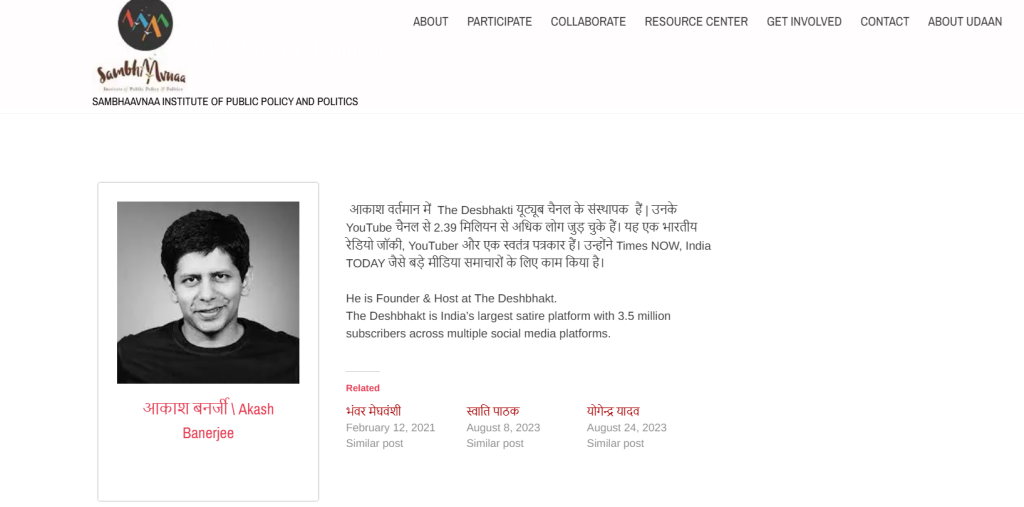
Sambhaavnaa’s activities are further linked to USAID-funded Internews, a global media organization accused of steering narratives in politically sensitive regions. Internews, which has funneled millions into media training and fact-checking initiatives, supports Factshala in India, a program tied to controversial media figures like Shekhar Gupta (The Print) and Ritu Kapur (The Quint). This connection exposes a broader strategy of foreign-funded influence over India’s media landscape, aimed at promoting leftist narratives under the guise of media literacy and social justice. The institute’s ties to USAID and its association with propagandists like Banerjee highlight its role in shaping anti-government discourse in India.
US’ History Of Interfering With Internal Affairs Of Other Countries
The US has a long history of meddling in the internal affairs of other nations, including India. Over the years, Washington has been accused of interfering in the political affairs and elections of India, Bangladesh, and several other countries. US government bodies have routinely targeted the Modi administration through biased reports on human rights, hate speech, and minority rights, often relying on leftist sources. On multiple occasions, the US government has issued unsolicited statements on India’s internal policy matters under the pretext of “deep concerns.” For instance, the US State Department’s statement in support of the 2020–21 farmers’ protests against the Modi government’s agricultural reforms were condemned by New Delhi as unwarranted interference. Similarly, US lawmakers criticized India’s Citizenship Amendment Act (CAA) in 2019, labeling it discriminatory, and the US House of Representatives held hearings on human rights in Kashmir after the abrogation of Article 370.
Eric Garcetti, the US Ambassador to India, has repeatedly made direct remarks on India’s domestic issues. In a recent instance, he commented on the Manipur violence, offering unsolicited opinions on the situation. He even took a veiled jab at Prime Minister Narendra Modi following his visit to Russia, suggesting that India’s strategic autonomy does not exist in times of conflict—implying that the US disapproves of India’s independent foreign policy. It is evident that the US prefers a weak Indian government, one that can be easily influenced, rather than a strong, assertive leadership like Modi’s.
Since direct interventions have failed to shift India’s major policy decisions, the US appears to be exploring subtler means to shape public opinion. One such method is the recruitment and training of “fact-checkers” under the pretense of promoting media literacy. The US Embassy in India has launched the “Empowering Media Savvy Youth” project, allocating a budget of $200,000 to “combat online manipulation” and “reinforce regional security.” This initiative raises concerns about the US’s real intentions—would Washington tolerate similar programs initiated by the Indian Embassy in the US to shape American public opinion?
The US’s Strategy: Influencers, Fact-Checkers, And Media Training
This pattern of influence is not confined to India. The Biden administration itself has adopted a strategy of paying influencers to control narratives and sway public opinion. Reports suggest that ahead of the upcoming US presidential elections, the Democratic National Committee (DNC) has engaged around 150 influencers across platforms like Instagram, TikTok, and YouTube, spending over $1 million on pro-Biden content. By leveraging influencers, the administration aims to reach young voters who increasingly consume news through social media rather than mainstream media. The CIA has also used pop culture and digital platforms to subtly push narratives in both domestic and international arenas, making intelligence agencies less conspicuous while maximizing their influence.
Ultimately, the US’s growing influence over Indian social media, fact-checking networks, and media literacy programs points to a larger strategy of narrative control. Whether through embassy-endorsed influencers, strategic funding of media training programs, or intelligence-backed digital campaigns, the US is actively shaping India’s information landscape while maintaining the illusion of non-interference. This neo-colonial approach undermines India’s sovereignty and the principles of genuine bilateral cooperation. If the US truly values its partnership with India, it must respect the country’s right to independent policymaking, rather than attempting to engineer public opinion through carefully orchestrated influence campaigns.
(With input from OpIndia)
Subscribe to our channels on Telegram, WhatsApp, and Instagram and get the best stories of the day delivered to you personally.

